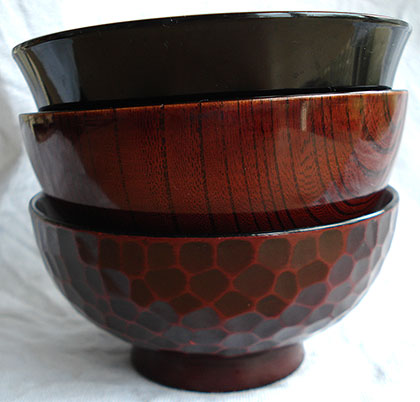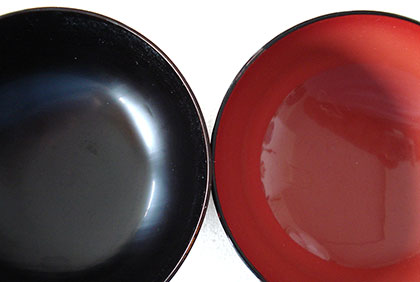Miso soup wrapup, and choosing and caring for lacquered soup bowls
 The top black bowl is resin; the bottom two are real lacquered bowls.
The top black bowl is resin; the bottom two are real lacquered bowls.
Food Destinations took up all of my weekend time, and the past two days, blogging wise, but I wanted to wrap up the week of miso soup, and also talk about the black-and-red lacquerware - and lacquerware-like - bowls that the soup is traditionally served in.
Miso soup redux
There are of course many, many more variations of miso soup; the basic thing to remember are the following:
- For any ingredients that need to be cooked, make sure to cook them first - either separately (e.g. grilling or parboiling) or in the dashi stock, before adding the miso.
- Never let miso soup come to a rolling boil after you add the miso. You will lose much of the aroma and flavor. (Unless of course, you don't actually like miso and are only having the soup for health reasons...)
- Add instantly cooked or delicate items at the last minute.
- Remember that regular miso is quite salty. If you are having miso soup with rice, the Japanese way, then your soup can be a bit heavier on the miso. If you are having miso soup on its own, go easier on the miso.
I'll have more miso soup recipes in the future I'm sure, but I hope that the 5 recipes got you thinking about your own variations.
Lacquered (and "lacquered") bowls for miso soup
Miso soup bowls are traditionally made of turned or carved wood, that is lacquered with natural lacquer and decorated.
However, most of the bowls you see at restaurants outside of Japan are made of resin or plastic. You can easily tell a plastic/resin bowl, since it is of a uniform thickness all around, and also gets hot outside very quickly. They are also a little flexible. (If you get a bowl of miso or clear soup at a restaurant with a lid on, and the lid refuses to come off, gently squeeze the sides of the bowl and twist-pull the lid.)
The bottom of areal lacquered bowl will be a bit thicker than the sides, and feel substantial in your hand. The bowl will also be expensive. At Jlist.com for example, they sell the plastic-resin type of bowls for under $3, but the real lacquered wooden bowls are $14 (pretty reasonable prices even if you figure in the cost of shipping from Japan).
If you just want the look of the bowls, the plastic-resin bowls are quite nice enough. Some of them almost look like the real thing, with convincing wood grain and such. I have four real lacquered bowls, and 12 black plastic ones with lids. Besides using them for soup, they also make different serving bowls for other things like salads or appetizers - the black or red interior surface makes a dramatic color statement. I've served pale-colored ice cream and sorbet in mine quite often. They are also easy to care for, and usually can go into the top rack of a dishwasher (though I prefer to hand wash mine). Always check the maker's recommendations though. The cheaper, flimsy ones may not stand up well in the heat of a dishwasher.

Real lacquer bowls need some tender loving care to prevent the lacquer from chipping or flaking off the wood base. This is a problem in overheated, very dry houses and apartments. Japan is quite a humid country, and lacquer bowls love humidity and hate dry conditions. If you live in a desert climate, you may want to consider sticking to the plastic-resin bowls unless you can provide extra humidity in the room where your bowls are stored.
The house I live in now is not that overheated, but it can get rather dry in the winter. So I keep my real lacquered bowls wrapped in soft cloth in a closed cabinet, and run a humidifier. (Some people like to put cups of water in the cabinet.) Don't ever put real lacquer ware in the dishwasher - hand wash only! If you have hard water, wipe the bowls after washing or they will get an unslightly white scale on them, which is very visible against the dark colors. Keep it out of sunlight also, since it dislikes ultraviolet rays. This applies to lacquered boxes too, though in my experience bowls seem to be more susceptible to flaking and chipping, perhaps because of their shape.
Why bother with real lacquer bowls at all? you might wonder. On a practical level they do hold in heat a lot better than the plastic-resin type. However, the reason for me to bother with the maintenance issues is they just feel wonderful - warm, substantial, and alive, in a way that plastic or resin can never emulate.
If you enjoyed this article, please consider becoming my patron via Patreon. ^_^

 Welcome to Just Hungry, where we serve authentic Japanese recipes and more! I'm
Welcome to Just Hungry, where we serve authentic Japanese recipes and more! I'm 














Comments
Anni
8 September, 2006 - 04:56
Permalink
Miso soup wrapup, and choosing and caring for lacquered soup bow
Maki!
You have given me new inspiration to seek and find these beautiful, versatile bowls. I love all sorts of vessels!
Since we consume quite a bit of soup and liquid meals during the winter months, these lovelies will make great additions to my batterie de cuisine!
Love the changes too!
Tootles,
Anni :-)
Andreas
5 July, 2015 - 17:07
Permalink
Here you can buy they are
Here you can buy they are expensive though but worth every penny http://www.iichi.com/shop/fushimiurushikobo
Joe Marfice
8 June, 2010 - 16:39
Permalink
Re: Miso soup wrapup, and choosing and caring for lacquered ...
Yes, you have inspired me to experiment more with miso soup! Thanks!
Ari
26 January, 2011 - 13:18
Permalink
Re: Miso soup wrapup, and choosing and caring for lacquered ...
This is an ancient post by now (September 2006!!!), but do you have any recommendations on where to order some of the genuine lacquered bowls you mentioned? Everywhere I look seems to only have the plastic ones.
Thanks in advance.
anon.
29 January, 2012 - 22:57
Permalink
Re: Miso soup wrapup, and choosing and caring for lacquered ...
hi ari. well this post is a year later than yours. i am doing some early spring cleaning & decided i would try to sell my lacquer bowls (set of 8 - 10). i believe they are wood. did the heat test and am able to hold the bowl after i put steaming hot soup into it & put the cover on the bowl. the soup stayed piping hot but only warm to the touch on the outside of the bowl. if you're still interested in bowls , please respond here & then we can correspond more. thanks, z
Nancy Hall
25 March, 2011 - 02:23
Permalink
Re: Miso soup wrapup, and choosing and caring for lacquered ...
I had four beautiful lacquered bowls. We put them in the dishwasher (numerous times) and now they are ruined. The problem is that we love the size and how they feel. Is there any way we can re lacquer them?